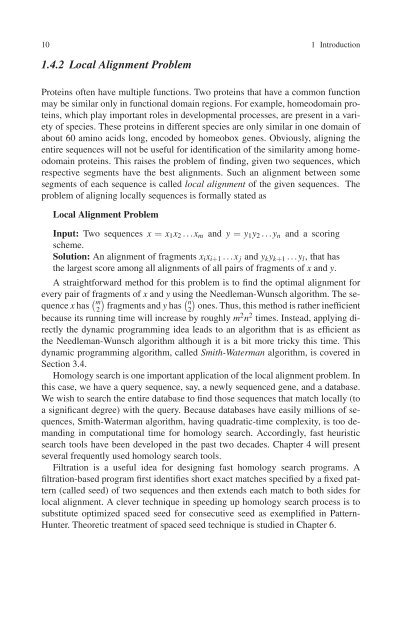Create successful ePaper yourself
Turn your PDF publications into a flip-book with our unique Google optimized e-Paper software.
10 1 Introduction<br />
1.4.2 Local Alignment Problem<br />
Proteins often have multiple functions. Two proteins that have a common function<br />
may be similar only in functional domain regions. For example, homeodomain proteins,<br />
which play important roles in developmental processes, are present in a variety<br />
of species. These proteins in different species are only similar in one domain of<br />
about 60 amino acids long, encoded by homeobox genes. Obviously, aligning the<br />
entire sequences will not be useful for identification of the similarity among homeodomain<br />
proteins. This raises the problem of finding, given two sequences, which<br />
respective segments have the best alignments. Such an alignment between some<br />
segments of each sequence is called local alignment of the given sequences. The<br />
problem of aligning locally sequences is formally stated as<br />
Local Alignment Problem<br />
Input: Two sequences x = x 1 x 2 ...x m and y = y 1 y 2 ...y n and a scoring<br />
scheme.<br />
Solution: An alignment of fragments x i x i+1 ...x j and y k y k+1 ...y l , that has<br />
the largest score among all alignments of all pairs of fragments of x and y.<br />
A straightforward method for this problem is to find the optimal alignment for<br />
every pair of fragments of x and y using the Needleman-Wunsch algorithm. The sequence<br />
x has ( m<br />
(<br />
2)<br />
fragments and y has<br />
n<br />
2)<br />
ones. Thus, this method is rather inefficient<br />
because its running time will increase by roughly m 2 n 2 times. Instead, applying directly<br />
the dynamic programming idea leads to an algorithm that is as efficient as<br />
the Needleman-Wunsch algorithm although it is a bit more tricky this time. This<br />
dynamic programming algorithm, called Smith-Waterman algorithm, is covered in<br />
Section 3.4.<br />
Homology search is one important application of the local alignment problem. In<br />
this case, we have a query sequence, say, a newly sequenced gene, and a database.<br />
We wish to search the entire database to find those sequences that match locally (to<br />
a significant degree) with the query. Because databases have easily millions of sequences,<br />
Smith-Waterman algorithm, having quadratic-time complexity, is too demanding<br />
in computational time for homology search. Accordingly, fast heuristic<br />
search tools have been developed in the past two decades. Chapter 4 will present<br />
several frequently used homology search tools.<br />
Filtration is a useful idea for designing fast homology search programs. A<br />
filtration-based program first identifies short exact matches specified by a fixed pattern<br />
(called seed) of two sequences and then extends each match to both sides for<br />
local alignment. A clever technique in speeding up homology search process is to<br />
substitute optimized spaced seed for consecutive seed as exemplified in Pattern-<br />
Hunter. Theoretic treatment of spaced seed technique is studied in Chapter 6.

















